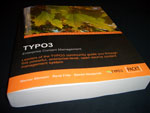
Popular Topics
Choose
Popular Links
Review: Typo3 Enterprise Content Management
updated by rck, 2005-09-19

I've been asked to review a book. It's called Typo3 Enterprise Content Management, it's about Typo3 and it contains a lot of information.
In this article, I'm trying to find out the focus of the book, the target audience and try to write a bit about its content, too.
Looking at the content (ch. 3 to end) | |
|---|---|
Typo3 for Editors (chapter 3) | |
|---|---|
|
This chapter should include about everything an editor of a Typo3 site should need know. It starts with half a page about reasons why to use a CMS, a page about usability aspects and half a page about the role of the editor. The chapter is rather easy to understand (like the previous and following ones) and comes to the point quite quickly while being rather detailed. After a solid introduction to the Typo3-Editor interface, the authors describe how to put content in your site. There are 3 pages about a nice Typo3 feature that isn't too common amongst open-source CMSes: The User | Task center. It includes internal notes, a list of recent pages, a task list and an internal messaging system for authors of a given site. The rest of the chapter introduces an efficient example workflow and gives tip about every-day Typo3 use. |
|
Typo3 for Administrators (chapter 4)

After explaining the duties of an administrator, this chapter has a big focus on permissions. How can an admin create users and give them rights for various things?
The chapter continues by explaining TSconfig, which appears to be a TypoScript-driven Typo3 registry. With TSconfig, someone can for example limit the editing history or change template captions.
There's also an example on how to set up a news workflow, how to set up Front-End users (the “registered users” of a site), database checks, and Digital Assets Management
Half a page about the future of administration in Typo3 concludes this chapter. The author foresees complete versioning of Typo3 content.
Developing with and extending Typo3 (chapters 5 to end) | |
|---|---|
|
The rest of the book is directed towards developers. Chapter 5 writes about TypoScript, which can be used to customize Typo3 a big deal. This chapter also explains, how to write templates and menus and even dedicates 15 pages to the future of TypoScript. Chapter 6 and 7 are about extensions. Chapter 6 introduces work with the Extension Repository (you can install remote Typo3 extensions without leaving your Backend interface) and the extension kickstarter for quick extension developement Chapter 7 is the last chapter of the book and dedicated to the developement of Typo3 extensions. The chapter starts with a “visitor counter in 20 minutes” and explains the Typo3 framework in great detail. The rest of the chapter is almost equally divided amongst front-end and back-end programming, including examples. Subchapters about services and developement tools conclude this book. |
|
About the structure
Looking at the content (foreword to ch. 2)
Looking at the content (ch. 3 to end)
Conclusion
Polls
| The comments are owned by the poster. We are not responsible for its content. |

What's Related
Article Manager
CMS
- Comparing static webpages with phpWebSite
- An interview with Francisco Burzi
- Dragging users into groups
- Cropping Images
- Portal und CMS
Link Manager
CMS
- Medienpraxis.ch
- Open Source CMS
- Mason Content Management
- Digimaker .NET Content Management System (CMS)
- ContentMetrics
- Why is Mambo better than postnuke?
- PHP CMS
- Contentmanager.de
- CMS Wire
- CMS Info
Documents
CMS
RSS News Feeds
CMS
Latest Updates
AdministrativeTexts
updated by freddiemac1993, 2013-06-14
wiki
Re: adventures
created by brittdavis10, 2012-02-23 (1 rply, 3 views)
thread
Re: how to run phpwebsite...
created by alexander, 2011-08-25 (2 rpls, 3607 views)
thread
Re: Forum tags
created by HaroldFaragher, 2011-08-22 (3 rpls, 8488 views)
thread

